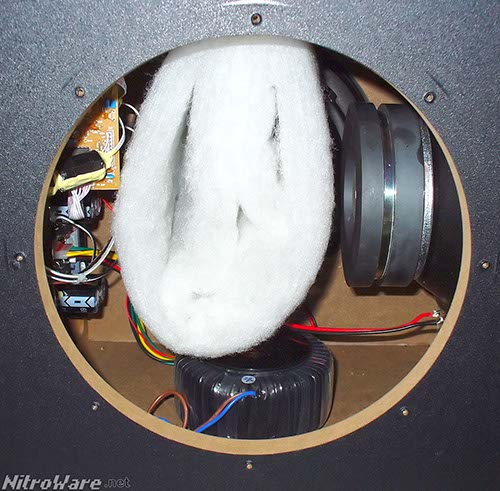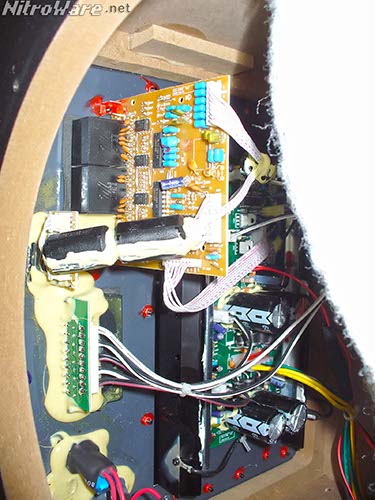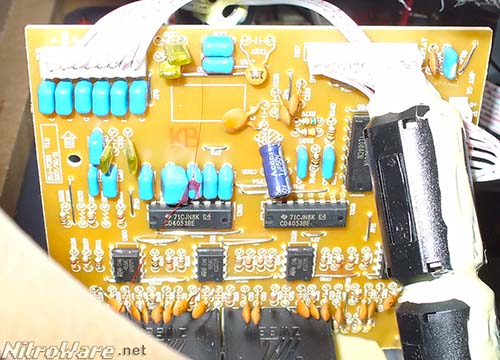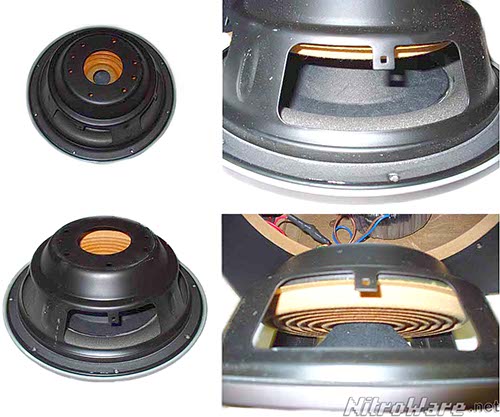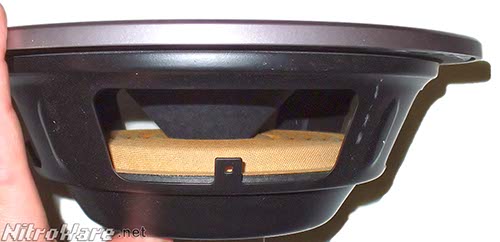Sub woofer
 The sub woofer unit is the heart and brains of the speaker system. It not only houses the active powered sub woofer speaker-driver itself but in the case of this product specifically it contains two additional passive bass radiator drivers to add additional low end power to the system. All the power, electronics and processing capability is housed in this unit.
The sub woofer unit is the heart and brains of the speaker system. It not only houses the active powered sub woofer speaker-driver itself but in the case of this product specifically it contains two additional passive bass radiator drivers to add additional low end power to the system. All the power, electronics and processing capability is housed in this unit.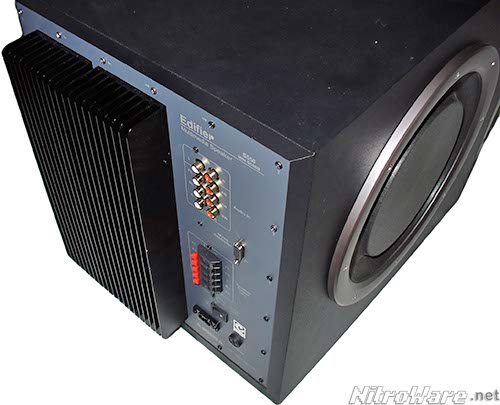
Before we delve into details, the 125 watts RMS sub woofer unit itself is large and heavy. Not only does the cabinet house THREE 10" bass drivers which themselves take a lot space up but and the cabinet is large enough to be used as a seat (we do not recommend attempting this) but the sub woofer is heavy as well, the whole sub woofer weighs 25 Kilograms !. A suitable location with accessibility, heat dissipation and safety and good audio projection should be considered before permanently placing the sub woofer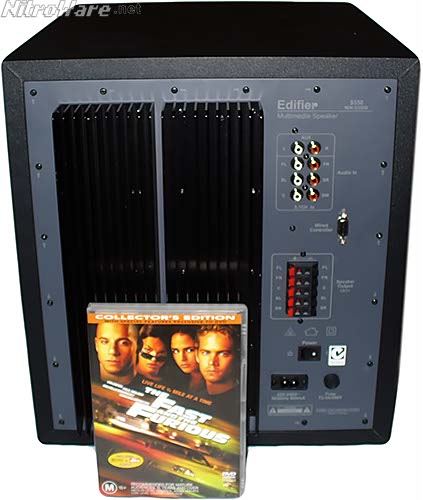
The sub woofer unit measures 367mm wide, 397mm high and 489mm deep.
The rear face of the sub woofer provides all the connections, power socket , main power switch ,mains fuse and heat-sinks for the amplifier.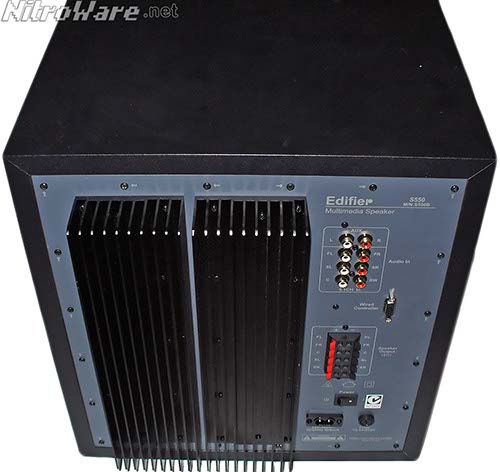
The S550 features a 6 channel analogue input by RCA sockets. A DVD player can be connected directly to the speaker using the bundled cables or a PC with a 6channel sound card can be connected using the bundled cables plus the bundled adapters.
A secondary input is provided for a second device, any device with the appropriate cable can be connected. An additional cable/adapter is not bundled for the extra input.
Owners of portable music players will need to connect using this input as a convenient auxiliary input is not included in the control pod.
The Front, Rear and Centre speakers are connected by speaker wire to sprung terminals on the speakers to sprung terminals on the sub woofer Other brands used fixed captive cables which not only can not be replaced or upgraded but if there is a fault with the connections the speaker can not easily be repaired. With this speaker if there is a problem with the speaker terminals they can be be fixed relatively easily under under warranty or by any competent electronics technician to replace the speaker terminals, a common part.
The terminals themselves are average at best. We did not test the speaker with aftermarket speaker cables so we cannot attest to their strength with larger gauge speaker cable. After some repetitive connection, the speaker cable conductors ere only slightly bent and did not need to be re-stripped and re-tinned.
AC Power is handled by a mains switch, two pin ungrounded AC socket and a user-replicable 2.5 Amp fuse. Other speaker brands and cheaper models do not offer any of these three features.
The power switch allows the system to be turned off completely to save power. The AC figure 8 socket allows of use of a common and cheap AC cord, easily customised to the region of use or replaced with a longer or short cable. The replaceable mains fuse protects the system from drawing more than the maximum design current. The end user can easily and cheaply replace the fuse without having to send the heavy sub woofer for service.
Note the speaker we tested is an Australian region unit. The Edifier S550B is set up for 220-240 volts AC operation and our test unit was bundled with an Australian power cord. The speaker system is not multivoltage. Other regions of the world will have a customised model for their power system with a different name. Being an Australian unit, a C-Tick Certification mark is present on the unit.
The sub woofer has very large heat sinks for its size, although given the size of the sub woofer and total output power for all six channels of 300 watts RMS the size of the heat sinks is not surprising.
Thankfully the heat-sinks run cool to touch and only ended up slightly warm during extended power use. They never got hot or uncomfortably hot . However our statement is based on testing the speaker is an open space and not in a tight enclosed space. Some users may push the sub against a wall or under a desk. Additionally, the edges of the heat sink fins are machined round and smooth so they will not cut the body if brushed against, will not cut any cables or damage furnishings. Again a feature overlooked by other vendors.
For those interested in the internal workings of the speakers, Edifier describe the design or components used in their premium signature speaker line on their website as other audio specialist's do such as such as Pioneer, Yamaha and Sony have done at times. At the time of our review the text of this information was not available in English, however we did our own analysis to see what made these speakers tick.
Safety warning: Amplifier manufacturers enclose or seal their products for a reason. Dangerous live AC voltages are present in such products and the power amplifiers themselves operate at high DC voltages. The information below is for research and background information purposes and in no way is a disassembly or repair guide. Do not risk your safety or the product warranty.We have disassembled and analysed the product so you wont have to.
Power supply and Power Amplifier
All the speakers in this set have the drivers fixed to the cabinets with hex screws. removing one of the side bass radiators reveals the heart of the system. From left to right we have the electronics, speaker padding and behind it the other bass radiator, below is mains transformer and to the right is the powered sub woofer
The following is the mains power wiring for the system comprising of the AC Mains power input, mains power switch, mains fuse, line filter which filters out any transients and smooths the voltage out so the listener hears glitch free sound and the mains Toroid transformer which drops the mains power down to levels which the electronics can work with, as well as supplying enough power to feed the hungry and powerful amplifiers.
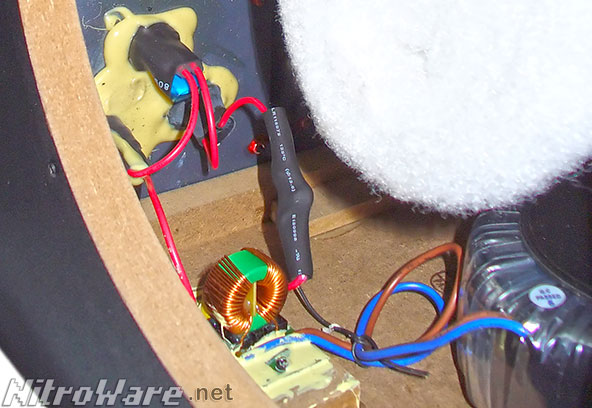
The complete circuitry that operates the speaker system comprises of the mains AC power line filter and power transformer, input switching and preamplifier board (brown), AC-DC power supply and power amplifier (green). All gaps joints and wiring are sealed with glue to prevent any rattling which can cause distortion and to prevent any parts from coming loose.
The power amplifier chips are mounted vertically alongside each of the heat sinks (black) for optimum cooling. The main circuit board and its components is of a better quality than the input board. Like the speakers themselves all the main wires are detachable from the main circuit board. This indicates care was taken during the design and construction. Better capacitors than those fitted are desired.
Edifier state that the following chips power its amplifier sourced from ST Microelectronics
TDA7294 100W DMOS Audio Amplifier and TDA7296 60W DMOS Audio Amplifier.
These chips are used in multiples to power the five satellite speakers and the sub woofer We were unable to determine what design was used however the power ratings Edifier state are achievable with these parts according to their data sheets.
As described by ST's data sheets, both parts are " a monolithic integrated circuit in Multiwatt15 package, intended for use as audio class AB amplifier in Hi-fi field applications (Home Stereo, self powered loudspeakers, Top-class TV)"
All of the amplifiers used are of the Class A-B and not the cheaper Class D type. This is important for a speaker of this calibre and price point.
Specifications such as Total Harmonic Distortion stated in the data sheets match the claims Edifier make about their product.
Total power consumption was not stated.
Input switching and preamplifier
The input audio signals both the 2 channel stereo aux input and the 6 channel main input are fed though industry standard 4558 op-amp chips sourced from ST Microelectronics. The thing with the infamous 4558 op-amp chip is that they are the bane of so called 'audiophiles', who insist because the chip is cheap it is rubbish and are convinced they can hear a difference between different manufacturers and age of the 4558 chip when in fact the differences are largely immeasurable and any difference is a placebo effect.
The 4558 op-amp itself has been sold in the millions and is in millions of consumer audio devices worldwide over the past decades. In the S550 speaker the op-amp chips amplify and boost the to levels that the power amplifier can use to output the sound at loud levels.
Two CD4053 switch chips sourced from Texas Instruments control the state of the audio inputs. This circuit allows the user to switch between the inputs from the control pod.
Overall the preamplifier and switching board seems cheaply made and designed compared to the rest of the speaker. The components used such as the ceramic capacitors (orange discs) and the brown circuit board are low cost parts. The relevant cables have been clamped with magnets to filter out any interference from the sound. We expected something better for a A$600 speaker set.
Bass Drivers
The S550's party piece is its sub woofer and bass drivers. Small and large sub woofers typically use different designs of tuned cabinets and bass ports (the holes or slots in the back or front of a speaker cabinet) to enhance the bass of the speaker. To make the best use of this type of design a bigger and more powerful sub woofer drivers are needed. Larger drivers is not very practical for a multimedia speaker system and is not the most efficient use of power, space, or cost.
The main sub woofer itself is a large 10" unit with 8 ohms impedance and 120Watts RMS power which is front firing behind a metal grille. it takes up half of the depth of the sub woofer cabinet
Edifier, instead of equipping the S550's sub woofer with a bass port, have fitted a front-firing 10" sub woofer with two side firing 10" drivers on either side of the main sub woofer driver. These two side firing drivers are actually sub woofers but lacking their magnets and voice coils plus a diaphragm lid added on top of the speakers. As such these drivers are now called radiators, as these radiators reproduce the radiated bass from the main sub woofer driver.
Essentially the radiators can be thought of as drums that are played by the sub woofer rather than a drumstick. These use of radiators allows for a smaller speaker cabinet and better efficiency. The downside to this approach is cost, with three 'speakers' instead of one.
